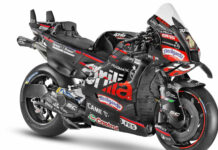Copyright 2003, Roadracing World Publishing, Inc.
Announcer and former racer Richard Chambers today contradicted claims made by AMA Pro Racing officials that cornerworkers did not report Steve Rapp’s bike hitting a bare concrete wall during Superbike qualifying on Friday of the Road Atlanta AMA National.
When asked why no soft barriers were installed after Rapp crashed and before Woody Deatherage hit the same section of bare wall two days later, breaking his back, AMA Pro Racing CEO Scott Hollingsworth and Road Racing Series Manager Ron Barrick both said that AMA officials did not know that Rapp’s bike had hit the wall, because cornerworkers did not inform AMA officials at the event.
Reacting to a report on Roadracingworld.com (6/11/03, AMA: Miscommunication Behind Failure To Deploy Soft Barriers Before Deatherage Hit Bare Wall), several readers who were at Road Atlanta pointed out that they had learned about the incident when announcers Richard Chambers and Chris Carter discussed the fact that Rapp’s bike had hit the wall. The readers found it hard to believe that AMA officials were not aware of those discussions over the public address system. The report also pointed out that Rapp’s crew men had discussed the fact that the bike had hit the wall with AMA Pro Racing Tech Inspector Terrie Siegfried, because they had to explain why the bike caught on fire–the tank ruptured when it hit the wall–before AMA Tech would release the motorcycle Friday afternoon.
And reached by phone today, Chambers said that not only had he announced that Rapp’s bike had hit the wall, he also heard cornerworkers report the wall impact to race control over the AMA radio network.
“We made comment on how lucky he (Rapp) was to be able to get up from the crash,” said Chambers. “We made comment about the thing pounding the wall and how difficult it was for the cornerworkers to pick it up and move it. You could see the debris from where the bike had hit.
“We first saw it on the Speed TV feed, and when they cut away from it I started listening to the cornerworker network,” continued Chambers. “They said that there was an incident in turns 4 and 5, and I heard somebody say the thing hit a wall, over the cornerworker network. Control was asking them to describe the incident. They mentioned that it went into this particular area and that the bike had hit the wall.”
AMA Pro Racing brings in its own race control person at AMA Nationals.
According to Hollingsworth, AMA Pro Racing has a policy of installing soft barriers whenever a new wall impact area is identified at a racetrack. But at Pikes Peak, two weeks after the incident at Road Atlanta, AMA Pro Road Racing Operations Assistant Jay Hannam said, when asked if Airfence would be put up where a rider hit the wall outside turn two, “We can’t put up Airfence every time somebody hits a wall.” At Road America, three weeks after the incident at Road Atlanta, Barrick and AMA Pro Racing Safety And Equipment Director Hugh Fleming (who handles soft barriers for AMA Pro Racing) said that they had never heard of any policy to install soft barriers whenever a new wall impact area is identified at a racetrack.
In both cases, at Pikes Peak and at Road America, additional soft barriers were eventually installed in front of bare walls hit by riders, including an impact that sent Aaron Gobert to the hospital with a broken wrist.
More, from a reader and cornerworker:
FIRST PERSON/OPINION
Via e-mail
Just a note to correct some possible misimpressions. I cornerworked the Road Atlanta AMA race and have been a cornerworker for the past 18 years. At Road Atlanta there is a dual communications system, a hard-wired com. system used for cars and a two-way radio network. There was person in the Race Control position on each system for all of the event, sort of co-race controllers. There are a couple of reasons I was told why there is the dual setup. One important one being that, since the hard-wired person on each turn is limited in mobility by the length of the wire at each station, there is a radio available so that there is communication available from all sight lines. The AMA also has an observer that sits with Race Control. The observer does not usually talk on the communications system but works with the person at the Race Control position to make control decisions, presumably, as the AMA would like them to be made. This has been my experience at Road A., Daytona and Loudon.
I can’t be certain that the AMA observer working with the control people at Road A. heard the cornerworkers describe the crash over the com. systems at the time. Perhaps the description came over the wired system which may not have been available to the AMA observer. These are questions that the persons that were there in control could answer. I do find it dubious that the statement was made that the AMA did not hear from the workers that the bike had hit the wall.
I was on the scene (I called to stop the race) on Sunday for Mr. Deatherage’s crash. An AMA official came out to the turn while we were still cleaning up and I and others told him what had happened.
Ed McFarland
Derry, New Hampshire
Updated Post: Announcer–Cornerworkers Reported Wall Hit At Road Atlanta
Updated Post: Announcer–Cornerworkers Reported Wall Hit At Road Atlanta
© 2003, Roadracing World Publishing, Inc.






